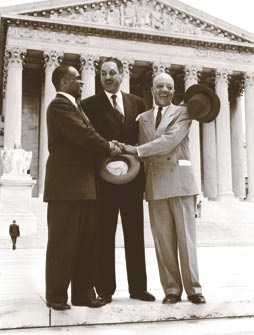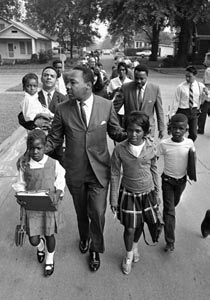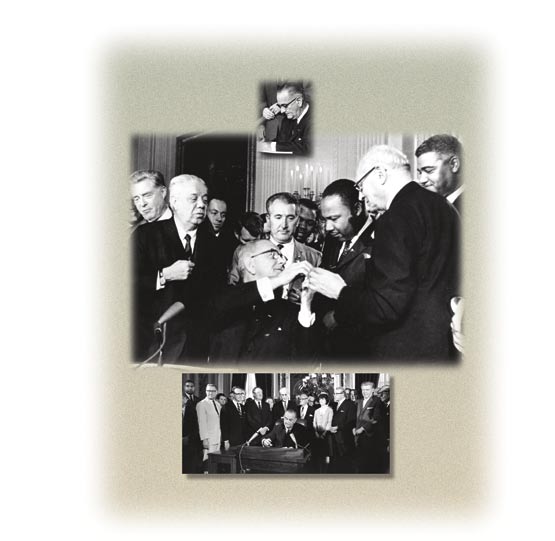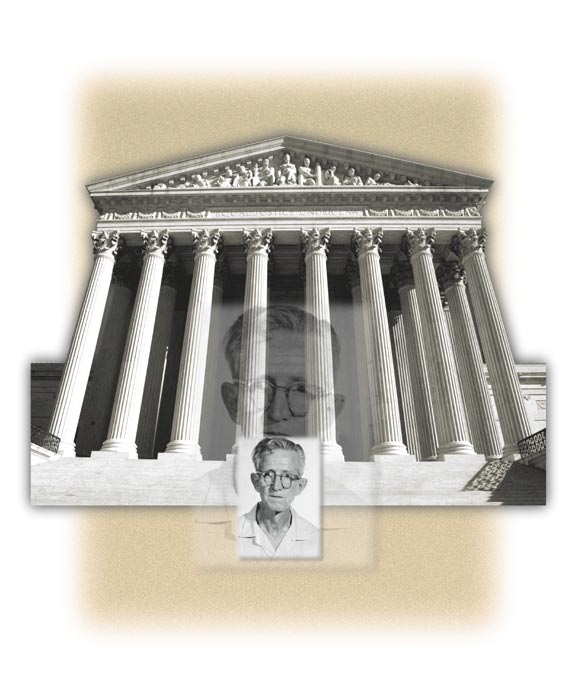parks and beaches, swimming pools, libraries, concert
Desegregation of public schools, enthusiasts like Mar-
halls, and movie theaters – further separated the races.
shall believed, would not only promote equality of op-
Negro travelers on southern highways never knew where
portunity in education; it would also advance interracial
they might find a bed for the night – or even a bathroom.
toleration. In time, the races might become integrated in
Some recreational areas posted signs, “Negroes [the word
a world wherein skin color would no longer cripple one’s
then used to identify African Americans] and Dogs Not
chances in life.
Allowed.”
This rigidly enforced system afflicted public education
at every level. All white state universities in the South
64

What Led to the Brown Decision segregation in the schools.
In retrospect, the decision to fight school segrega-
tion seems to have been obvious and necessary. At the
The Brown decision arose from the efforts of two
time, however, it was a highly controversial move. Many
groups of activists. The first were black parents
Negroes had no particular wish to send their children to
and liberal white allies who resolved to fight discrimina-
schools with whites. Other Negroes feared that deseg-
tion. Among the earliest of these activists were parents
regation – if it ever could be achieved – would lead to
in Clarendon County, South Carolina, who in 1947
the closing down of their schools, which, though starved
demanded provision of school buses for their children.
for resources, were nonetheless important institutions of
Parents in four other segregated districts – in the states
employment and of solidarity in the South. The decision
of Virginia, Delaware, and Kansas, and in the District
to challenge segregation head-on, moreover, provoked
of Columbia – also sought legal assistance. The Brown
even greater anger among southern whites. Governor
case, combining these five protests into one, took its
Herman Talmadge of Georgia declared that he would
name from Oliver Brown, a welder and World War II
never accept integrated schools. He later exclaimed that
veteran whose daughter, Linda, was barred from attend-
desegregation would lead to racial intermarriage and to
ing a white elementary school close to her
“mongrelization of the races.”
home in Topeka, Kansas. Instead, she had
But Marshall and his allies pressed
to arise early, walk across dangerous railroad
ahead, shepherding all five cases through
World War II,
switching yards, and cross Topeka’s busiest
the lower federal courts between 1950 and
commercial street in order to board a bus to
1952. Though they lost most of these cases
having been waged
take her to an all-Negro school.
– judges refused to overrule Plessy – they
At first, Negro parents did not dare to chal-
as a fight
took heart from wider developments at the
lenge segregation. Instead, they demanded
time that promised to advance better race
for democracy,
real equality within the “separate but equal”
relations. World War II having been waged
system. In doing so, they aroused fierce local
as a fight for democracy exposed the evils of
had dramatically
resistance. Whites fired black plaintiffs from
racism. American statesmen such as
their jobs and cut off their credit at local
exposed the
President Harry Truman, leading the West
banks. In Clarendon County, hostile whites
in the Cold War, were acutely aware that
evils of
later burned one of the churches of the Rev.
racial segregation in the United States,
Joseph DeLaine, a Negro protest leader.
mocking American claims to lead the “Free
racism.
When white opponents fired at his home in
World,” had to be challenged. Moreover,
the night, he shot back, jumped into a car,
millions of southern Negroes were then
and fled. South Carolina authorities branded
moving to the North, where they were a
him as a fugitive from justice, and he dared
great deal freer to organize and where their
not return to his home state.
votes could affect the outcome of local
The second group of activists consisted of lawyers
and national elections.
– most of them Negroes – who worked for the
For these and other reasons, many white Americans
Legal Defense Fund (LDF), an autonomous arm of the
in the North in the early 1950s were developing doubts
National Association for the Advancement of Colored
about segregation. As one writer later put it, “There was
People (NAACP). Chief among them was Marshall, a star
a current of history, and the Court became part of it.”
graduate of Howard University Law School, a predomi-
Truman, sensitive to the power of this current, had
nantly black school in Washington, D.C., that trained
ordered desegregation of America’s armed forces in 1948.
many bright attorneys in the 1930s and 1940s. Marshall,
His Justice Department supported Marshall’s legal briefs
a folksy and courageous advocate, had long been manag-
when the Brown cases first reached the Supreme Court
ing cases on behalf of Negro causes, notably the deseg-
for hearing in December 1952.
regation of law schools. Responding to pleas from black
The Court, however, was an uncertain quantity. Chief
parents in Clarendon County, he engaged the LDF in
Justice Fred Vinson, who hailed from the border state of
the struggle to promote racial equality in public school
Kentucky, was one of at least three of the nine justices
systems. In 1950, deciding that true equality could never
on the Court who were believed to oppose desegregation
exist within a separate but equal system, he and other
of the schools at the time. Two other justices were appar-
NAACP leaders decided to call for the abolition of racial
ently undecided. It was clear that the Court was deeply
65


divided on the issue – so much so that advocates of racial
Putting the Court’s Ruling Into
justice dared not predict victory.
At this point, luck intervened to help the Legal De-
Practice
fense Fund and its plaintiffs. In September 1953, Vinson
died suddenly of a heart attack. Hearing of Vinson’s
death, Justice Felix Frankfurter, a foe of the chief, reput-
This was an historic decision. More than 50 years
edly commented to an aide, “This is the first indication
later, it remains one of the most significant Su-
I have ever had that there is a God.” To replace Vinson,
preme Court rulings in U.S. history. In focusing on public
President Dwight Eisenhower appointed California Gov-
schools, Brown aimed at the core of segregation. It subse-
ernor Earl Warren as chief. In doing so, the president, a
quently served as a precedent for Court decisions in the
conservative on racial issues, did not anticipate that War-
late 1950s that ordered the desegregation of other public
ren would advocate the desegregation of schools. But the
facilities – beaches, municipal golf courses, and (follow-
new chief justice soon surprised him. A liberal at heart,
ing a year-long black boycott in 1955-56) buses in Mont-
Warren moved quickly to persuade his colleagues to over-
gomery, Alabama. It was obvious, moreover, that no other
turn school segregation.
governmental institution
In part because of War-
in the early 1950s – not the
ren’s efforts, the doubters
presidency under Eisen-
on the Court swung behind
hower, not the Congress
him. Announcing the Brown
(which was dominated by
decision in May 1954,
southerners) – was prepared
Warren stated that racial
to attack racial segregation.
segregation led to feelings
It was no wonder that El-
of inferiority among Negro
lison, Marshall, and many
children and damaged their
others hailed the ruling as a
motivation to learn. His
pivotal moment in Ameri-
opinion concluded, “In the
can race relations.
field of public education
It soon became obvi-
the doctrine of ‘separate but
ous, however, that Brown
equal’ has no place. Sepa-
would not work wonders.
rate educational facilities
Like many Supreme Court
are inherently unequal.”
decisions in American his-
Negro children, he argued,
tory, the ruling was limited
had been deprived of the
to specific issues raised by
“equal protection” of the
the cases. Thus, it did not
laws guaranteed by the 14th
explicitly concern itself
Amendment to the United
with many other forms of
States Constitution.
This group of lawyers (left to right, George E.C. Hayes, Thurgood Marshall, and James M. Nabrit) surmised that appealing to the courts was the most likely way to achieve the political goal of abolishing segregation. Marshall later became a Supreme Court justice.
66

racial segregation – as in public accommodations – or
with more informal but pervasive forms of racial dis-
Impetus for the Civil Rights
crimination, as in voting and employment. It deliberately
avoided challenging a host of state laws that outlawed
Movement
racial intermarriage. Targeting only publicly sponsored
school segregation, Brown had no direct legal impact on
Thereafter, liberals finally made progress in their
schools in other parts of the nation. There, racially imbal-
fight for the desegregation of schools. The driving
anced schools were less the result of state or local laws
force behind their gains was the civil rights movement,
(of de jure discrimination) than of informal actions ( de
which swelled with enormous speed and power between
facto discrimination) based on the reality of races inhabit-
1960 and 1965. In 1964-65, pressure from the movement
ing different neighborhoods. In the 1950s, as later, de
compelled Congress to approve two historic laws, the
facto segregated neighborhoods – and schools – flour-
Civil Rights Act of 1964 and the Voting Rights Act of
ished in the American North.
1965. Vigorously enforced by federal officials within the
The Brown decision was cautious in another way:
administration of President Lyndon Johnson (1963-69),
because Warren and his fellow justices feared to push
these measures succeeded in virtually demolishing a
segregating districts too hard, they did not order the im-
host of discriminatory racial practices, including segrega-
mediate dismantling of school segregation. Instead, they
tion in public accommodations. In particular, the Civil
deliberated for a year, at which point they issued a sec-
Rights Act authorized cutting off federal financial aid to
ond ruling, Brown II, which avoided specifying what sort
local school districts that continued to evade the mes-
of racial balance might constitute compliance. Refusing
sage of Brown. Responding to the more militantly liberal
to set a specific deadline for action, Brown II stated that
temper of the times, the federal courts, including the
desegregation should be carried out with “all deliberate
Supreme Court, began ordering school officials not only
speed.” This fuzzy phrase encouraged southern white
to desegregate without delay but also to establish “racial
authorities to procrastinate and gave federal courts in
balance.” By the late 1970s, roughly 40 percent of black
the South little guidance in resolving disputes that were
public school pupils in the South were attending schools
already arising.
in which the student population was at least 50 percent
It is virtually certain, however, that whatever the
white.
Court might have said in 1954-55, and no matter how
What did the Brown decision have to do with the rise
slowly it was willing to go, southern whites would have
of the civil rights movement – and therefore with these
fought fiercely against enforcement of Brown. Indeed,
dramatic changes? In considering this question, schol-
and most ironically, schools then and later proved the
ars and others have offered varied answers. When the
most sensitive and resistant of America’s public insti-
movement shot forward in the early 1960s, many people
tutions to changes in racial relations. Though many
believed that Brown was a crucial catalyst of it. Then and
districts in the border states slowly desegregated, whites
later they have also argued that this first major decision
in the Deep South (often aided by the Ku Klux Klan
energized and emboldened what became known as the
and other extremist groups) bitterly opposed change.
liberal “Warren Court,” which zealously advanced the
In 1956, virtually all southerners in Congress issued the
rights of minorities, criminal defendants, poor people,
so-called Southern Manifesto pledging to oppose school
and others in need of legal protection. Among the men
desegregation by “all lawful means.” In 1957, Arkansas
who helped to propel this liberal judicial surge was Thur-
Governor Orval Faubus openly defied the Court, forcing
good Marshall, whom Johnson named as America’s first
a reluctant President Eisenhower – who never endorsed
black Supreme Court justice in 1967.
the Brown decision – to send in federal troops to enforce
Today, most scholars agree that Brown was symboli-
token desegregation of Central High School in Little
cally useful to leaders of the civil rights movement.
Rock. There – as in New Orleans, Nashville, Charlotte,
After all, the law, at last, was on their side. “Separate
and many other places – angry whites took to the streets
but equal” no longer enjoyed constitutional sanction.
in order to harass and intimidate black pupils on their
They also agree that Brown, the first key decision of the
way to school. In 1964, 10 years after Brown, fewer than
Warren Court, stimulated a broader rights consciousness
2 percent of black students in the South attended public
that excited and in many ways empowered other groups
schools with whites.
– women, the elderly, the disabled, gay people, and other
minorities – after 1960. These are the most important
long-range legacies of the decision.
67



It is not so clear, however, that Brown was uniformly
are gone forever.
effective in the task it was supposed to accomplish, which
But it is also obvious that Brown has not changed ev-
was to promote complete desegregation of public school
erything. In the 2000s, considerable racial inequality per-
systems. On the contrary, by 1960 it was apparent that
sists in the United States. The median income of blacks,
the legal strategies employed by men such as Marshall
though far better in real terms than earlier, remains at
had failed to achieve desegregation of the schools. Real-
around 70 percent of median white income. Millions of
izing the limitations of litigation, which moved slowly,
African Americans continue to reside in central city areas
civil rights leaders like the Reverend Martin Luther King
where poverty, crime, and drug addiction remain serious.
Jr., as well as militant activists in organizations like the
Though de jure segregation is, of course, now banned,
Congress of Racial Equality (CORE) and the Student
barriers of income, culture, and mutual distrust still often
Nonviolent Coordinating Committee (SNCC), seized on
separate the races. Especially in urban areas, public
strategies of direct action. One strategy was “sit-ins,”
schools have re-segregated since the mid-1980s. In the
where crowds of blacks sat down in places they weren’t
‘70s and ‘80s, courts, seeking to create racially balanced
supposed to go in the segregated South. Another was
schools, mandated a certain amount of complex busing
“freedom rides,” where activ-
of pupils from one school district
ists boarded buses headed South
to another, at the local level.
to force desegregation of na-
Labeled “forced busing” by its
tional bus lines and bus terminals
opponents, this action proved
– actions that provoked violent
wildly unpopular among many
responses by mobs of local whites.
whites. Thus, while many
There were also mass demon-
liberals have opposed re-segrega-
strations. These confrontations,
tion in recent years, they have
unleashing violence that flashed
received relatively little support
across millions of TV screens,
from the courts, which since the
shocked Americans into demand-
1990s have generally ruled that
ing that the government take
de facto residential segregation,
action to protect the ideals and
not intentionally racist public
values of the nation.
policies, have promoted this
re-segregating process, and that
The Brown
such segregation is not subject
to further attempts at judicial
Decision Today
reversal. Many black people,
concerned, like whites, above
all with sending their children
to good schools, have concluded
Since the 1950s, America’s
that engaging in protracted legal
race relations have greatly
battles for educational desegre-
improved. White attitudes are
gation plans involving busing or
more liberal. A considerable black
other complicated methods is
middle class has arisen. Some
no longer worth the effort or the
“affirmative action” policies aimed Civil rights leader Martin Luther King Jr., leading black children expense.
at preventing discrimination,
to all-white schools in Mississippi in 1966. Dr. King became the
Today, the percentage of black
public face of the ‘60s civil rights movement;
scarcely imagined in the 1950s
he was later assassinated.
students in the South that attend
and 1960s, have secured Supreme
white majority public schools has
Court approval. The historic civil rights laws of the 1960s
declined to around 30. Because many northern industrial
continue to enjoy solid political support. Talented African
cities by now have overwhelmingly black populations
Americans have risen to a range of leadership positions,
in parts of their central cores, the percentages of black
including secretary of state of the United States. Thanks
students attending such schools outside the South are
in part to the change in society and culture signaled and
even lower. Hispanic Americans also often attend racially
indeed initiated by Brown, the Bad Old Days of
imbalanced schools. Many schools mainly attended by
constitutionally sanctioned, state-sponsored segregation
minority students are inferior – in per pupil spending
68


and the training of teachers, certainly in levels of student
in the workplace. But in the United States, as else-
achievement – to predominantly white schools in nearby
where in the world, the struggle to create societies where
affluent suburban districts.
all are truly equal has yet to achieve its goal.
If Ralph Ellison or Thurgood Marshall were alive to-
day, each would undoubtedly be pleased that Brown ulti-
James T. Patterson, an historian of modern America, retired from teaching at mately helped to kill de jure school segregation. But they
Brown University in 2002. His recent books include Grand Expectations: would also recognize that the dramatic decision, while a
The United States, 1945-1974 (winner of the Bancroft Prize in history); necessary step toward the promotion of racial justice, did
Brown v. Board of Education: A Civil Rights Milestone and
not lead to the establishment of a uniformly integrated
Its Troubled Legacy; and Restless Giant: The United States from
society. Whites and blacks in the United States are far
Watergate to Bush v. Gore.
more integrated than they were 50 years ago, especially
Brown changed the temper of the times, and led to national civil rights legislation, especially during the presidency of Lyndon B. Johnson (inset top).
Center: Johnson hands Dr. King a pen used to sign the Civil Rights Act of 1964.
Below: Johnson signs the Voting Rights Act of 1965, a law that made
it easier for black Americans to vote.
69


As with the Zenger trial centuries earlier, the fate of one uncelebrated citizen changed American law.
By granting Clarence Earl Gideon the right to a defense attorney at state expense in 1963, the Supreme Court made it easier for the poor to de














